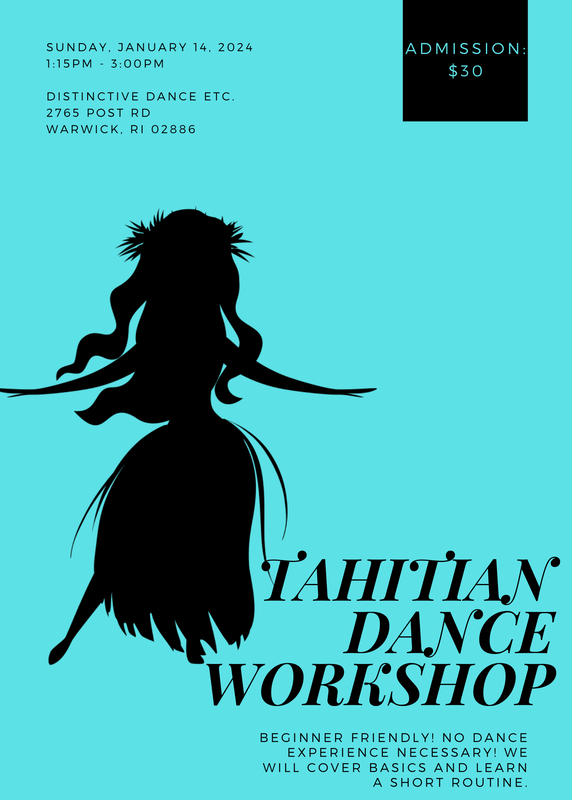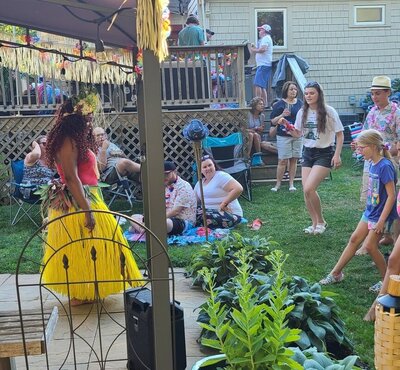Are you looking to try something new in 2024? Try Tahitian dance! It is a beautiful art and a great form of exercise. Join us for our beginner-friendly workshop in January!
Once you sign up, you will receive a confirmation email within 24 hours. Later, look for an email within a few days of the workshop with all the information you'll need! The FAQs page will help you prepare for the class. Please contact us here if you need additional information.
**Please note: The workshop is subject to cancellation if there are not enough sign-ups. If that happens, you will receive a refund of your class fee. In the case of inclement weather, we will postpone the workshop and/or the class may be held online instead (via Zoom).**
Class location:
Distinctive Dance Etc.
2765 Post Rd, Warwick, RI 02886
*Note: A parent/guardian must be present for the check-in for participants under 18. For participants under 13, a parent/guardian must be present for the entire class (if it is the child's first class with Teaona Performing Arts).
To sign up, click the button below:
We are starting our regular group classes on January 21st! Click here to learn more!
About Polynesian Dance
Polynesia is a region of island nations in the Pacific Ocean. Hawai’i, though now a US state, is a former nation of its own in that region. Polynesian cultures have some similarities with each other, but there are also a lot of differences to be noted. The dances differ vastly. Unfortunately, misinformation has made it difficult for some to discern what is what. For example, Tahitian dance (‘ori Tahiti) is confused for Hawaiian dance (hula) often. This is due in part to shows featuring many dances from different Polynesian islands being performed all at once, but it is also due to misinformed performers not differentiating between the two different styles. What a lot of people think of as hula—fast-moving hips, fast drumming, coconut bras with grass skirts, sarongs (pareo/pareu), and large headdresses—is actually Tahitian dance. These dances are very sacred to each nation and their integrity must be preserved by teachers and practitioners of the dance.
Why Learn from Teaona Performing Arts?
Polynesian dance—which includes Hawaiian, Tahitian, Maori, Samoan dance, and many others—is very culturally rich and requires in-depth knowledge. Each of these cultures is quite unique, even while they share similarities with each other. The dances are no exception to this, and it takes a great deal of dedication to understand the differences and the cultural context of each dance. Jessica, the Teaona Performing Arts leader and instructor, has put in a lot of that work and studied Hawaiian dance (hula) and Tahitian dance (‘ori Tahiti) since 2005, and she continues to learn more today. She has kept up with workshops from Polynesian teachers throughout the years. She has also upheld the teachings of her kumu hula (hula teachers) even after moving states. When learning Polynesian dance, you want to make sure you’re learning from someone who honors the traditions and values of the cultures from which the dance comes and will teach you the same. Jessica is that someone! Jessica has been a performer of hula and ‘ori Tahiti for more than 15 years and has experience teaching both adults and children.
What will you learn?
Movement |
Mixed Levels |
Theory |
Learn and drill dance movements, including hand gestures, steps, and more. Work toward learning choreography! |
Combos will always be beginner-friendly. If you’ve already got some ‘ori training under your belt, there will be more challenging versions of the combos to keep you engaged! |
Learn the history and culture from which the dance comes. We will discuss cultural legends and myths that inspire any choreography you learn. Also learn the different types of dance performed. |



